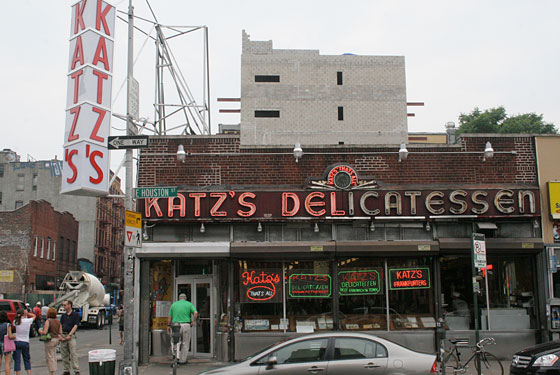
1888: Katz’s Delicatessen, now the city’s oldest deli, opens on the Lower East Side. The specialties then, as now, were hot meat sandwiches: corned beef, pastrami, brisket of beef.
1914: Arnold Reuben, owner of Reuben’s Restaurant and Delicatessen at 802 Park Avenue, prepares a sandwich of rye bread, Virginia ham, roast turkey, Swiss cheese, coleslaw, and Russian dressing for an actress. The Reuben is born.
1922: Italian immigrant Nick Defonte opens his sandwich shop in Red Hook.
1930s: A lack of funding for large marketing campaigns during the Great Depression forces companies—and desperate job seekers—to resort to sandwich-board advertising.
1932: Chock Full o’Nuts stores, which previously sold just nuts, then just nuts and coffee, begin offering cream-cheese sandwiches on date bread. Owner William Black insists that employees use tongs instead of hands to prepare the food, and even goes so far as to install “Food Not Touched by Human Hands” signs throughout the Chock Cafes.
1937: Carnegie Deli opens across from Carnegie Hall in midtown. Average sandwich dimensions in 1937: two inches high and stuffed with a quarter pound of meat. Averag today: six inches, one pound of meat.
1965: The BMT, consisting of Genoa salami, pepperoni, and ham, and named for the Brooklyn-Manhattan Transit Corporation, is added to Subway’s sandwich menu. The name is later modified to Biggest Meatiest Tastiest.
1982: Richard LaMotta starts selling Chipwich ice-cream sandwiches for $1 each through an army of 60 street-cart vendors. Before long LaMotta is selling 40,000 per day.
1982: Cantankerous, suspender-wearing sandwich-monger Kenny Shopsin opens Shopsin’s General Store in Greenwich Village.
1984: The Carnegie Deli provides the main setting for Woody Allen’s Broadway Danny Rose. Owner Leo Steiner adds a Danny Rose special (corned beef, pastrami, and a side of coleslaw) to the menu.
1987: Tom Cat Bakery opens in a 1,300-square-foot garage in Long Island City. The company now has a 45,000-square-foot headquarters, employs 275 people, and provides the bread for sandwich chains like Hale and Hearty Soups.
1995: Gavin Kaysen, now the executive chef at Cafe Boulud, starts his culinary career slinging sandwiches at a Subway in Edina, Minnesota.
1990s: The artisanal-sandwich-bread craze hits a fever pitch: Amy’s Bread opens in 1992, with Sullivan St Bakery following in 1994, and then Bouley and Balthazar Bakeries in 1997. The traditional choice of white, wheat, or rye bread is expanded to include options like seven-grain and focaccia, with or without seeds, egg wash, or onions.
1997: Chef Alain Coumont opens the first U.S. outpost of Belgian-based bakery chain Le Pain Quotidien on Madison Avenue. Tartines hit Manhattan.
1998: Jason Denton and his wife, Jennifer, open ’ino in a former West Village dog-grooming salon, kicking off a citywide panini frenzy.
1998: Peanut Butter & Co. opens in Greenwich Village with twelve different types of peanut-butter sandwiches. It’s the beginning of the ultra-sandwich-specialization craze (Grilled Cheese NYC and Say Cheese came later).
2003: Chefs Tom Colicchio and Sisha Ortuzar open ’wichcraft, an artisanal-sandwich chain inspired by the way chefs eat: standing in the kitchen at the end of the shift, starving, refashioning whatever’s left over from dinner into a sandwich.
2010: Restaurateur Danny Meyer opens Sandwiched, a pop-up café in the Whitney Museum of Art featuring highbrow sandwich creations from chefs Michael Anthony (Gramercy Tavern), Carmen Quagliata (Union Square Cafe), Floyd Cardoz (Tabla), Kenny Callaghan (Blue Smoke), and Robb Garceau (Hudson Yards).